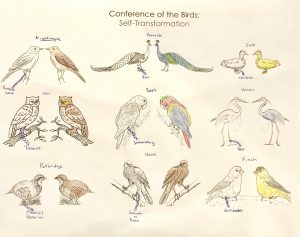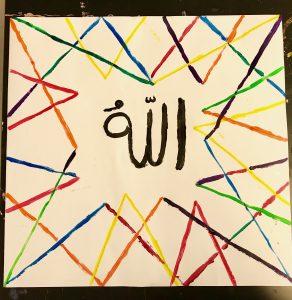Introductory Essay
ø
The United States of America, a champion of religious freedom, has one of the most religiously diverse populations in the world. With such religious diversity and constitutional investment in the protection of the freedom to practice any religion, one would expect Americans to have a level of religious literacy that is on par with other religiously diverse nations, yet that is not the case. A Pew Research study recently found, “large numbers of Americans are uninformed about the tenets, practices, history and leading figures of major faith traditions – including their own.” Ignorance regarding religion promotes bigotry, prejudice, and hostility which in turn restricts peaceful coexistence and respect for pluralism locally, nationally, and even across borders. Specifically, in the case of Islam in America, I have personally experienced and witnessed the effects of said ignorance on people of my Muslim community and those around the world. Misrepresentation and bigotry of Islam has served as a form of justification for the violence and marginalization that is exercised on Muslims across the nation. According to the FBI, from the years 2001 to 2015, there were 2,545 anti-Islamic incidents targeting 3,052 Muslims. Due in large part because of Ignorance and preconceived notions, Muslims have been murdered in their homes and outside their mosques, they have been beaten in their stores, at schools, and on the street. They have been kicked off of airplanes, intentionally set on fire, bullied, disrespected, and constantly made to feel like they do not belong.
In thinking about this ignorance and the affects it has on people’s lives and perceptions, I began to question my perception and understanding of religions other than my own. However, this semester with professor Ali Asani also made me grapple with my understanding and perception of my own religion, Islam. After a mere couple of lectures, I came to the recognition that I too am ignorant about Islam. Learning about a religion that has always been a part of my life made me realize there is a distinction/difference between religious learning through a devotional lens and learning about religion from an academic one. While both are legitimate and serve distinct (but at time complementary) ends, I realized a large gap in my understanding of Islam from a wholistic academic perspective. Having grown up Muslim, my whole life, I have looked at Islam from the devotional perspective that I inherited from my family and Muslim community. However, this class with professor Asani has shown me that my lens/perspective is one of so many. It has shown me that Islam is far from the monolith that so many, even Muslims, see it as being and that while devotional learning is important for faith, a cultural studies approach is just as important for understanding Islam as a religion that influences so much in the world.
Our cultural studies approach to studying Islam throughout this course was driven by three main understandings. The first understanding was that Islam (as with other religions) is internally diverse, meaning there is not one type of Islam. The premise of this understanding is that within Islam there is a multitude of expressions, interpretations, traditions, and beliefs that have their own validity and understanding that I was not truly aware of. The second understanding was that Islam is a dynamic religion that has not and will not be the same over time. Islam is always evolving and changing in response to the evolving context of history. The last (and possibly most important) understanding was that Islam is and has been deeply imbedded in all dimensions and contexts of human life. Islam, along with other religions, is a phenomenon that throughout history has been ingrained in the social, historical, economic, literary, and artistic contexts of nations, empires, and societies. To truly understand Islam, we must learn about and analyze the contexts that it has influenced and vice versa. Because this approach to studying Islam was such an integral part of this class and because it truly altered my perception of the religion, I decided to dedicate a creative response to illustrate the approach and the impact it has had on me. In my first piece, titled “Cultural Studies Approach to Understanding Islam”, I try my best to illustrate the complexities and interwoven contexts for understanding Islam by using intersecting lines of varying colors to depict all the connected and unconnected interpretations, beliefs, contexts, and traditions that go into painting an understanding of Islam. In the middle of the painting is the word “Allah” in Arabic, which is intended to show that at the end of the day, even amidst all of the tensions and differences in context, the main connecting variable between them all is the desire to worship God and build a relationship with him.
With the cultural studies approach, we spent a lot of our time focusing on literary and artistic pieces to grasp understanding of Islam. From studying calligraphy and mosque designs to analyzing epic Persian poems and paintings we delve deep into unlocking the role that Art plays in explaining Islam. This was a very interesting topic for me because growing up, I did not think that Art and Islam went together. From my mom not allowing me to hang up paintings in my room to my Sunday school teachers telling me that I should not listen to music, I grew up with the impression that art was not an integral part of Islam. However, this class has shown me how significant aesthetics and art are/have been in Islam. In this class we have seen examples of Muslims using art to praise God, illustrate their interpretations, and express their Islam. Some of my favorite examples from class were the Sufi rock band Junoon, the Ta’ziyah, and Turkish Whirling Dervishes. Each of these examples played a role in showing me that Art and Islam are not mutually exclusive. In fact, it showed me how integral art has/continues to be in so many aspects of Islam. In addition to getting this understanding I was also able to start seeing the artistry that is involved in some of the traditional/standard aspects of Islam that I never saw as works of art. I began to be able to observe small artistic things like the melody of different calls to prayer, the poeticism of the Quran, and the intricacies and symbols that are found in mosque architecture and design. By looking at these aspects of Islamic (looking at mosques designs in different parts of the world) that have become so normalized to me through an artistic interpretation lens helped me understand the idea that arts and literature offer a unique window by which we can observe a nation or particular culture’s interpretation, understanding, and expression of Islam.
To illustrate this new found appreciation for Islamic art and the role it plays in understanding the religion with context, I dedicated two creative responses to illustrate the art that goes into recitation and Quran design. The first piece, which was inspired by the documentary we watched in class called “Koran by Heart”, is an audio compilation of 7 different Quran reciters who each have their own unique sound and style of reciting. The purpose of this creative response is to show the artistry that goes into Quran recitation and that although each style is different they each have their own beauty. In addition to this, there is something to learn from the popularity/preferences of certain recitation styles from country to country as each style evokes its own emotion. The other piece, which is a collage of the designs found on different opening pages of the Quran, is intended to show the importance of aesthetics and beauty in Islam. More specifically, the idea that beauty and aesthetics are loved by God and are signs of divinity.
Another important theme in this class that has been critical for the comprehension of Islam is the fundamental divisions that have persisted in Islam. In lecture, we traced much of the diversity in the Muslim world to tensions, both religious and political, that arose in the centuries after the Prophet Muhammad’s death. For example, Sunni and Shi’a communities were divided by disagreements on who the rightful successor to the Prophet was. To learn about and understand the views of these communities of interpretations, especially the Shia community, we looked to art and literature. For example, we studied the Shi’a tradition of the Ta’ziyeh, a passion play commemorating Imam Hussein and his family’s suffering at the hands of the Sunni caliphs, we investigated poems written by Shia poets, and analyzed paintings of Ali, Hussain, and Hassan. In studying these different communities of interpretation in Islam, one of the unifying variables I observed is the belief in Muhammad and the idea that he is the ideal example for humankind. To illustrate this, I created a lamp with the names of the different communities of interpretation written along the sides and “Muhammad” on the top. The symbolism of the lamp is to illustrate the idea that Muhammad is seen as a guiding light for not just Muslims but also all of humanity.
While I did find learning about the history, traditions, and beliefs of the different communities of interpretation interesting, the one that really resonated and intrigued me was that of Sufism. Sufism, which is a mystical form of Islamic belief and practice, promotes the inward search for God and demotes materialism. To get a better understanding of the beliefs of Sufi’s, we read and discussed many poems (as it is believed that simple prose would not adequately express the mystical experiences and feelings felt by many Sufi’s). Many times, the poems we read communicated through symbolism and metaphors, the deepness of Sufi spirituality, the complexity of mystical love, and the importance of self-transformation. Of all the poems we read, the one that I enjoyed the most was the epic poem “Conference of the Birds”. What I loved most about this poem was that it did an amazing job illustrating the journey that different individuals must go to realize God. I especially liked the emphasis of self-transformation and the letting go of the attachments and vices that hold us back from connecting with God. In short, the goal of Sufism is to cleanse the heart, to educate, or transform, the self, and to find God. For most people the idea of the self is dominated by pride, egotism, and pursuit of worldly pleasure and Sufi’s believe this level of self leads people away from the Truth. In one of my creative responses titled “Conference of the Birds: Self-Transformation”, I touch on this theme of self-transformation and detachment that is important in Sufi thought. In creating a piece that attempts to show the transformation of the characters in the poem, I try to highlight the idea that without detachment from the things that consume our love and energy we cannot connect with God in the way that we should. In another one of my pieces, titled “Ghazal inspired by Persepolis”, I try to reconstruct the idea of an inward search for God found in Sufi belief into an inward search for finding your identity.
My experience in AI54 this semester has been an incredibly enlightening and thought provoking one. I feel that I have left the class with a much more wholistic understanding of the religion I have practiced my whole life. In addition to this, this class has shown me the political, economic, and social impacts that religions have on the world and as I graduate and move on to the next chapter of my life, I hope to continue to push myself in seeking religious literacy and understanding.




